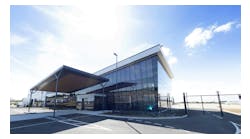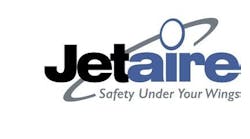Aug. 24—For an airline passenger looking out the window of a jet, it's alarming to see the metal cover in the midsection of the engine pod flapping open, shredding like thin paper, then ripping off and sending debris backward to ricochet into the wing and fuselage.
That was the troubling view out the windows Monday for passengers aboard an Alaska Airlines Boeing 737. As the San Diego-bound flight lifted off from Seattle-Tacoma International Airport, the covers on both sides of the left engine pod — called a nacelle — came loose.
When the pilots promptly turned back to Seattle, the covers ripped off completely on landing and pieces hit the fuselage.
The jet landed safely and none of the 182 passengers and crew onboard was injured. The passengers were rebooked on another flight.
Dozens of such accidents have happened over the past 30 years, much more often on the Airbus A320 than on the Boeing 737. Though a couple of those incidents turned more serious, none resulted in injuries.
This type of failure is very different from the rarer, but much more dangerous, accidents when an engine fan blade breaks off, causing catastrophic damage to the engine and sending heavy metal shrapnel into the airframe. Those are often caused by undetected long-term metal fatigue in the fan blades.
In contrast, in almost every case of the engine covers' flapping open and disintegrating, the cause has been traced to a preflight maintenance mechanic error and the subsequent missing of that error during preflight checks.
The Alaska incident was the second such failure on a Boeing 737 in the U.S. this month. On a Southwest Airlines flight from Orlando, Florida, on Aug. 12, the same covers ripped off as the jet landed in St. Louis. Again, no one was injured.
Airbus was forced to modify its A320 design after a series of such incidents.
Kyriakos Kourousis, a senior lecturer at the University of Limerick's School of Engineering in Ireland, who did an extensive survey of the Airbus accidents and wrote a paper examining the role of human error and the efficacy of the modification, said it "may be a good idea at this point to do a follow-up survey on the 737."
The parts that failed in all these incidents are called the fan cowl doors, covers on each side of the pod around the engine that hinge upward like seagull wings to provide maintenance mechanics access to the engine.
In the dozens of incidents where the fan cowl door has ripped off, overwhelmingly it's because a mechanic failed to re-latch the doors properly before takeoff and preflight inspections by the pilots and maintenance supervisors missed the error.
Contributing to such errors, sometimes this maintenance work between flights may be done in the dark or performed in a hurry because the next flight is behind schedule.
The maintenance and preflight check procedures will certainly be the initial focus of an ongoing investigation by both Alaska Airlines and the Federal Aviation Administration into Monday's event. The FAA said it is also investigating the earlier incident in St. Louis.
Beyond confirming their ongoing investigations, Alaska and the FAA declined to comment Tuesday on potential causes.
Airbus forced to make a fix
Failure of the fan cowl doors in flight has historically been more of a problem on the Airbus A320 family of jets.
At least 45 such incidents on its A320s over three decades — some on jets with the same engines as are on the 737 — prompted Airbus to design a modification that was then mandated by both the European Aviation Safety Agency and the FAA.
Kourousis said the reason the 737 has a better record is simply that the latch for its fan cowl doors is close to the edge of the underside of the engine pod and therefore more easy to see from the side.
In contrast, the latch on the Airbus fan cowl doors is in the center of the underside of the pod and can be inspected only by crawling under it.
"It's easier on the Airbus jet for it not to be noticed," said Kourousis.
Unlike the heavy duty material used for the inlet cowl at the front end of a jet engine pod, which is designed to contain a fan blade breaking off, the fan cowl doors are made from relatively thin aluminum.
When pieces of these doors break off, they may typically only scratch or dent the airplane's wings, fuselage and tail.
However, in a couple of the Airbus incidents, both by chance involving British Airways planes, the metal debris punctured a fuel pipe and caused an engine fire.
Airbus finally was forced to act after the second of those more serious incidents in 2015, when the fan cowl doors from both engines detached from an A319 as it took off from London Heathrow.
The fuel leak ignited an engine fire in flight. After landing, passengers evacuated on escape slides.
In response, given this was the culmination of a series of incidents, Airbus designed a modification to the door latches, which would have to be locked and unlocked with a specific key. This key had a "remove before flight" flag attached to it and was required to be stored in a designated area in the cockpit.
Some airlines, including Air Canada and United Airlines, objected to this solution, arguing that human errors could still be made with this arrangement.
United said it had instituted a dual signoff procedure for the locking of the fan cowl doors and had no subsequent incidents afterward.
Despite those objections, the FAA and EASA mandated the Airbus modification in 2018, at an estimated cost to U.S. airlines of $4.3 million to make the fixes on 400 airplanes within three years.
Kourousis' 2018 paper concludes that the Airbus A320 modification will "contribute positively" to reducing the fan cowl door failures. However, it also recommended additional changes to procedures.
These included a dual signoff procedure such as United introduced; maintenance shift handover protocols; and focused training to encourage better communication and a collaborative attitude in the airline maintenance culture.
Following the investigation into Monday's incident, such "human factor" recommendations are likely to be at the top of Alaska's agenda as it seeks to prevent future failures.
___
(c)2022 The Seattle Times
Visit The Seattle Times at www.seattletimes.com
Distributed by Tribune Content Agency, LLC.


